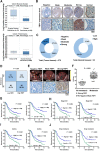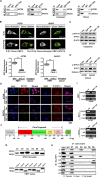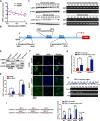FBP1 regulates proliferation, metastasis, and chemoresistance by participating in C-MYC/STAT3 signaling axis in ovarian cancer
- PMID: 34363022
- PMCID: PMC8497274
- DOI: 10.1038/s41388-021-01957-5
FBP1 regulates proliferation, metastasis, and chemoresistance by participating in C-MYC/STAT3 signaling axis in ovarian cancer
Abstract
Fructose-1,6-bisphosphatase (FBP1) is a rate-limiting enzyme in gluconeogenesis and an important tumor suppressor in human malignancies. Here, we aimed to investigate the expression profile of FBP1 in ovarian cancer, the molecular mechanisms that regulate FBP1 expression and to examine how the FBP1 regulatory axis contributes to tumorigenesis and progression in ovarian cancer. We showed that FBP1 expression was significantly decreased in ovarian cancer tissues compared with normal ovarian tissues, and low-FBP1 expression predicted poor prognosis in patients with ovarian cancer. The enhanced expression of FBP1 in ovarian cancer cell lines suppressed proliferation and 2-D/3-D invasion, reduced aerobic glycolysis, and sensitized cancer cells to cisplatin-induced apoptosis. Moreover, DNA methylation and C-MYC binding at the promoter inhibited FBP1 expression. Furthermore, through physical interactions with signal transducer and activator of transcription 3 (STAT3), FBP1 suppressed nuclear translocation of STAT3 and exerted its non-metabolic enzymatic activity to induce the dysfunction of STAT3. Thus, our study suggests that FBP1 may be a valuable prognostic predictor for ovarian cancer. C-MYC-dependent downregulation of FBP1 acted as a tumor suppressor via modulating STAT3, and the C-MYC/FBP1/STAT3 axis could be a therapeutic target.
© 2021. The Author(s).
Conflict of interest statement
The authors declare no competing interests.
Figures






Similar articles
-
Decreased Expression of Fructose-1,6-bisphosphatase Associates with Glucose Metabolism and Tumor Progression in Hepatocellular Carcinoma.Cancer Res. 2016 Jun 1;76(11):3265-76. doi: 10.1158/0008-5472.CAN-15-2601. Epub 2016 Apr 6. Cancer Res. 2016. PMID: 27197151
-
Fructose-1,6-bisphosphatase loss modulates STAT3-dependent expression of PD-L1 and cancer immunity.Theranostics. 2020 Jan 1;10(3):1033-1045. doi: 10.7150/thno.38137. eCollection 2020. Theranostics. 2020. PMID: 31938049 Free PMC article.
-
FBP1 knockdown decreases ovarian cancer formation and cisplatin resistance through EZH2-mediated H3K27me3.Biosci Rep. 2022 Sep 30;42(9):BSR20221002. doi: 10.1042/BSR20221002. Biosci Rep. 2022. PMID: 36000567 Free PMC article.
-
Fructose-1,6-bisphosphatase 1 in cancer: Dual roles, mechanistic insights, and therapeutic potential - A comprehensive review.Int J Biol Macromol. 2025 Mar;293:139273. doi: 10.1016/j.ijbiomac.2024.139273. Epub 2025 Jan 1. Int J Biol Macromol. 2025. PMID: 39753180 Review.
-
The role of fructose-1,6-bisphosphatase 1 on regulating the cancer progression and drug resistance.Discov Oncol. 2025 Mar 18;16(1):346. doi: 10.1007/s12672-025-02112-2. Discov Oncol. 2025. PMID: 40100307 Free PMC article. Review.
Cited by
-
TCEB2/HIF1A signaling axis promotes chemoresistance in ovarian cancer cells by enhancing glycolysis and angiogenesis.Eur J Med Res. 2024 Sep 11;29(1):456. doi: 10.1186/s40001-024-02050-9. Eur J Med Res. 2024. PMID: 39261917 Free PMC article.
-
Decoding host-microbiome interactions through co-expression network analysis within the non-human primate intestine.mSystems. 2024 May 16;9(5):e0140523. doi: 10.1128/msystems.01405-23. Epub 2024 Apr 1. mSystems. 2024. PMID: 38557130 Free PMC article.
-
Effect of icariin on ovarian cancer: a combined network pharmacology and meta-analysis of in vitro studies approach.Front Pharmacol. 2024 Dec 20;15:1418111. doi: 10.3389/fphar.2024.1418111. eCollection 2024. Front Pharmacol. 2024. PMID: 39759453 Free PMC article.
-
Lactic acid metabolism: gynecological cancer's Achilles' heel.Discov Oncol. 2025 May 2;16(1):657. doi: 10.1007/s12672-025-02364-y. Discov Oncol. 2025. PMID: 40314877 Free PMC article. Review.
-
CDCA7 enhances STAT3 transcriptional activity to regulate aerobic glycolysis and promote pancreatic cancer progression and gemcitabine resistance.Cell Death Dis. 2025 Feb 4;16(1):68. doi: 10.1038/s41419-025-07399-1. Cell Death Dis. 2025. PMID: 39905019 Free PMC article.
References
-
- Siegel RL, Miller KD, Jemal A. Cancer statistics, 2016. CA: Cancer J Clin. 2016;66:7–30. - PubMed
Publication types
MeSH terms
Substances
LinkOut - more resources
Full Text Sources
Medical
Miscellaneous

